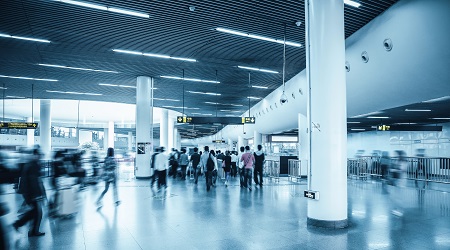Rail needs to be bold – it starts and ends with the customer
Rail needs to be bold – it starts and ends with the customer

Building a new kind of relationship with customers driven by data is key to unlocking opportunity and growth for UK rail.
Sarah Wray, editor, SmartCitiesWorld
 The UK rail industry stands at a “tipping point”. To seize the huge opportunity to boost revenue and play a central role in a fast-changing mobility landscape, the sector must focus on outcomes and building a new kind of relationship with customers, driven by data.
The UK rail industry stands at a “tipping point”. To seize the huge opportunity to boost revenue and play a central role in a fast-changing mobility landscape, the sector must focus on outcomes and building a new kind of relationship with customers, driven by data.
This was the conclusion from a recent Atos roundtable on the opportunities and challenges that digital technology presents for rail in the UK. Based on Atos’ Digital Vision for Mobility opinion paper, which explores the impact of digital transformation on the transport, personal mobility and logistics markets, the event brought together rail operators, technology suppliers, consultants and education providers to discuss the future of rail in the UK.
These are the key conclusions from the event:
Two worlds collide
Friction between the old and new worlds must give way to harmony and true collaboration to realise an immense opportunity. The railway engineer and the software engineer will need to increasingly work together.
Attendees were in broad agreement that change hasn’t been fast enough for the vast majority of our railways, and customers’ experience doesn’t always match their ever-increasing expectations. Rail’s reluctance to adopt new technology at the same speed we have seen elsewhere is understandable, given the industry’s justified and unwavering focus on safety and reliability. Despite this, rail has no choice but to transform in the face of both new competition and collaborative opportunities from areas such as Mobility-as-a Service (MaaS) and on-demand transport, as well as rising customer expectations – brought about by ever-improving digital experiences in sectors from retail to ride-hailing.
As Britain seeks to develop its competitive advantage internationally, rail remains at the centre of our country’s economic aspirations. There are areas ripe for improvement with access to high quality, reliable broadband somewhere near the top of the list.
With greater investment on the way, however (Network Rail plans to invest £42 billion into the UK’s rail infrastructure over the next five years), UK rail has the opportunity to develop lighthouse projects which show the art of the possible. A holistic transformation will include large-scale upgrades, such as the ongoing work to deploy digital signalling systems to significantly improve reliability and capacity. These changes won’t happen overnight, but this doesn’t mean the industry has to wait.
It’s critical that rail companies put the customer, not the railway, at the centre of their strategy and ‘piggy-back’ on the ubiquitous connectivity and infrastructure in their pockets – the smartphone. Work back from here and score some quick wins to encourage the sector was a key message.
A railway for today and tomorrow

The rail industry must also be bolder and think longer-term – what will the customer experience be like in 10 years, rather than two?
One attendee summed the situation up: “Rail can’t afford to work its way through all the steps the other industries have done. It needs to work out how it can leapfrog and start with new answers that are valid for today and tomorrow.”
New blood can help to drive this fresh thinking. Some companies are now exploring new approaches, including hackathons and reverse mentoring, where more experienced members of staff partner with newer recruits to learn from each other. Companies are also tentatively trialling schemes such as rotating 15 per cent of their team every year to bring in new ideas and different perspectives.
Another delegate noted that in aerospace, for instance, some large companies are starting to change procurement practices to encourage agility and ideas from outside, including start-ups. For example, one firm won’t contract work with suppliers unless at least 70 per cent of their work is with other clients.
Also critical to success in tapping these opportunities faster, is driving more investment into research and development (R&D) activities to foster a culture of experimentation and innovation. Insider estimates suggested that rail companies spend less than one per cent of overall budget on R&D, compared to other successful high-tech sectors which can spend upwards of 10 per cent.
Making these investment changes would also help to attract the next generation of bright thinkers into rail, and keep them enthused once they get there.
Demonstrate the possible, drive momentum
 Creating truly digital stations could be a major opportunity – with a flagship project centred on a major station in the North a viable option.
Creating truly digital stations could be a major opportunity – with a flagship project centred on a major station in the North a viable option.
This would mean digitising the entire experience, underpinned by robust connectivity. Such a ‘digital-first’ station could give passengers a fully integrated experience underpinned by technology-enabled services they have come to expect, all supported through better sharing of data which drives a deeper understanding of the customer base and support the continuous improvement of services, providing commercial opportunities while driving up social engagement. This virtuous circle utilises the insight enabling product and services to be refined, driving up customer satisfaction levels as a result.
It would also create a new kind of relationship between rail companies and passengers — a rail operator can become a real-time journey advisor, a “journey’s friend”, providing hints, tips and nudges along the customer’s route and layering on other relevant information: the location of the nearest coffee shop, services that might be of interest or relevant offers travellers might like to take advantage of on the go.
Simplifying fares and payment modes is also a priority for improving the customer relationship, as has been demonstrated by Transport for London’s (TfL) Oyster system.
The key is to identify and create these exemplar projects and keep moving. As one operator noted, going at the pace of the slowest puts progress at risk; seizing an idea that people can get behind, building momentum as you go, is key.
Unleash the power of data
Once rail companies begin to deploy digital technologies in this way, they will be better positioned to do much more with data, based on outcomes.
They’ll be able to use data to both understand the problems that they need to solve and to address them. They will also become more predictive – we’ve seen sensors and analytics successfully used in car parks, for example, to predict demand, manage the space and even drive innovation around pricing structures.
To deliver on customer expectations, openness and data aggregation is also key — looking through the lens of personal mobility, rather than simply rail. This means considering all aspects of the customer’s journey, from how they get to the train station and where they might stay when they arrive, to providing personalised retail offers for refreshments along the journey. Integrating personal transport and mobility tools, such as apps, so that they speak to one another rather than competing – even abroad – was highlighted as a goal to deliver a seamless experience.
Follow the customer

Commuter expectation is rising and the opportunity to meet and exceed this collective anticipation provides real opportunities. Once pioneers in the rail sector present commuters with the art of the possible and momentum builds around this, the rest of the industry may find that following suit is the logical choice.
The UK rail industry must be bold. Fresh obstacles will emerge as rail digitally transforms – from cybersecurity threats to debates about data ownership. Those challenges, too, will be defined – and tackled – by a relentless focus on outcomes.
Rail needs to place the passenger front and centre of the experience. Rooted in safety and reliability and moving to value, new and vital digital offerings and the flow of real-time information with every decision made done so with the commuter at the heart.
Related Resources
Our Expert

Sunil Munsif
Vice President & Sales Director – Transport, Atos UK & Ireland
Follow or contact Sunil:


